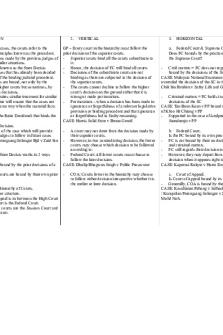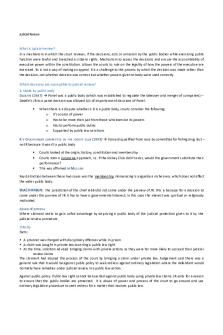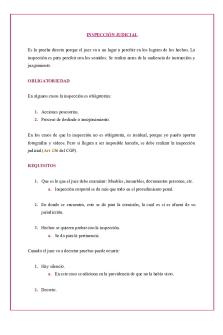Notes on Judicial Decisions PDF

| Title | Notes on Judicial Decisions |
|---|---|
| Course | Introduction To Malaysian Legal System |
| Institution | Universiti Teknologi MARA |
| Pages | 2 |
| File Size | 71.2 KB |
| File Type | |
| Total Downloads | 185 |
| Total Views | 503 |
Summary
1. DEFINITION In deciding cases, the courts refer to the accepted principles known as the precedent. Precedents – Decisions made by the previous judges of superior courts in similar situations. This rule is also known as the Stare Decisis SD: Stand by cases that has already been decided or the doctr...
Description
1. -
In deciding cases, the courts refer to the accepted principles known as the precedent. Precedents – Decisions made by the previous judges of superior courts in similar situations. - This rule is also known as the Stare Decisis SD: Stand by cases that has already been decided or the doctrine of the binding judicial precedent. - Hence, the courts are bound, not only by the decision of the higher courts but sometimes, by their on previous decisions. - Since justice requires similar treatment for similar cases, this doctrine will ensure that the cases are decided by the same way when the material facts are the same. - However, only the Ratio Decidendi that binds the latter courts. RD: Rationale for a decision. - A legal principle of the case which will provide precedence for judges to follow in future cases CASE: Kumpulan Perangsang Selangor Bjd v Zaid bin Hj Mohd Noh -
2.
DEFINITION
The doctrine of Stare Decisis works in 2 ways
Vertical = A court is bound by the prior decisions of a higher court Horizontal = Some courts are bound by their own prior decisions. Organization of the Hierarchy of Courts. - Uses the three-tier structure. - The Court of Appeal is in between the High Court and the apex court is the Federal Court. - The subordinate courts are the Session Court and the Magistrate Court.
3.
VERTICAL
GP – Every court in the hierarchy must follow the prior decision of the superior courts. - Superior courts bind all the courts subordinate to it. - Hence, the decision of FC will bind all courts - Decisions of the subordinate courts are not binding as there are subjected to the decision of the superior courts. - The courts cannot decline to follow the higher court’s decision on the ground either that it is wrong or made per incuriam. - Per incuriam – when a decision has been made in ignorance or forgetfulness of a relevant legislative provision or binding precedent and that ignorance or forgetfulness led to faulty reasoning. CASE: Harris Solid State v Bruno Gentil
HORIZONTAL
a. Federal Court & Supreme Court Does FC bounds by the practice and precedents of the Supreme Court? -
Civil matters = FC does not regard itself to be bound by the decisions of the Supreme Court. CASE: Malaysia National Insurance v Lim Tiok overruled the decision of the SC in the case of Tan Chik bin Ibrahim v Safey Life and General Insurance. -
Criminal matters = FC holds itself bound by decisions of the SC CASE: Tan Boon Kean v PP bound with the decision of Khoo Hi Chiang v PP - Supported in the case of Arulpragasan a/l Saandaraju v PP
A court may not deter from the decision made by their superior courts. - However, in two contradicting decision, the lower courts may choose which decision to be followed according to: - Federal Court: All lower courts must choose to follow the later decision. CASE: Dhalip Bhagwan Singh v Public Prosecutor
b. Federal Court. Is the FC bound by its own precedents? - FC is not bound by their on decision in both civil and criminal matters. - FC still regards their decision to be binding. - However, they may depart from their previous decision when it appears right to do so. CASE: Koperasi Rakyat v Harta Empat
-
c. Court of Appeal. Is Court of Appeal bound by its own decision? - Generally, COA is bound by their own decision. CASE: Kesultanan Pahang v Sathask Realty : Kumpulan Perangsang Selangor v Zaid bin Haji Mohd Noh.
-
COA: Courts lower in the hierarchy may choose to follow either decision irrespective whether it is the earlier or later decision.
-
However, there are also situations where the COA is allowed to disregard and not follow their earlier decision. Mentioned in: Young v Bristol Aeroplane Co. Ltd -
If there are two conflicting decisions, the court may choose which it will follow. However, the decision that it did not follow will be deemed overruled. - The court is bound to refuse to follow a decision of its own which, though not expressly overruled, cannot stand a later decision of the House of Lords - If that decision was given per incuriam.
c. High Courts -
HC are not bound by their own decisions but it has a persuasive effect. CASE: Sundralingam v Ramanathan Chettiar - Ng Hoi Cheu v PPT did not follow the decision of Wong Hang Fatt v PP - Joginder Singh v PP, the High Court held that it was not bound to follow a decision of the High Court in Hassan bin Isahak v PP.
ADVANTAGES AND DISADVANTAGES...
Similar Free PDFs

Notes on Judicial Decisions
- 2 Pages

Judicial Review notes
- 1 Pages

Judicial precedent - notes
- 4 Pages

Judicial Precedent Notes
- 8 Pages

Judicial Review Notes
- 6 Pages

Judicial Review - Lecture notes 1
- 30 Pages

Judicial Review
- 15 Pages

Inspección Judicial
- 4 Pages

Judicial Review
- 50 Pages

Recuperação Judicial
- 5 Pages

14 Capital Budgeting Decisions
- 51 Pages

Synthesis-making-informed-decisions
- 30 Pages
Popular Institutions
- Tinajero National High School - Annex
- Politeknik Caltex Riau
- Yokohama City University
- SGT University
- University of Al-Qadisiyah
- Divine Word College of Vigan
- Techniek College Rotterdam
- Universidade de Santiago
- Universiti Teknologi MARA Cawangan Johor Kampus Pasir Gudang
- Poltekkes Kemenkes Yogyakarta
- Baguio City National High School
- Colegio san marcos
- preparatoria uno
- Centro de Bachillerato Tecnológico Industrial y de Servicios No. 107
- Dalian Maritime University
- Quang Trung Secondary School
- Colegio Tecnológico en Informática
- Corporación Regional de Educación Superior
- Grupo CEDVA
- Dar Al Uloom University
- Centro de Estudios Preuniversitarios de la Universidad Nacional de Ingeniería
- 上智大学
- Aakash International School, Nuna Majara
- San Felipe Neri Catholic School
- Kang Chiao International School - New Taipei City
- Misamis Occidental National High School
- Institución Educativa Escuela Normal Juan Ladrilleros
- Kolehiyo ng Pantukan
- Batanes State College
- Instituto Continental
- Sekolah Menengah Kejuruan Kesehatan Kaltara (Tarakan)
- Colegio de La Inmaculada Concepcion - Cebu



